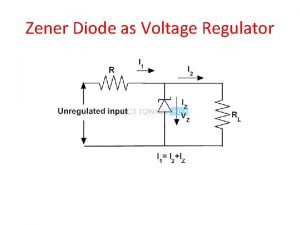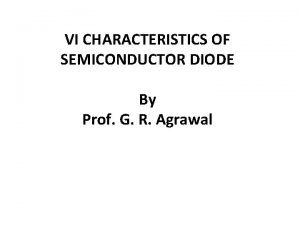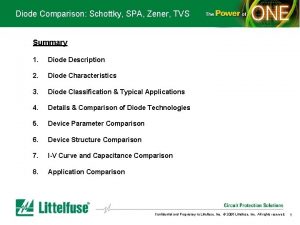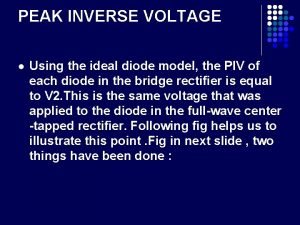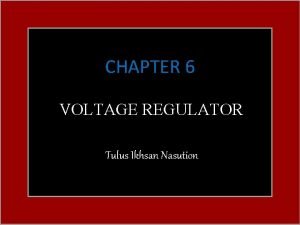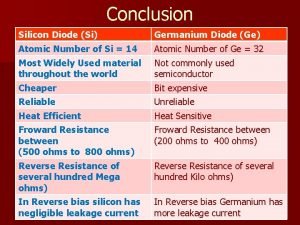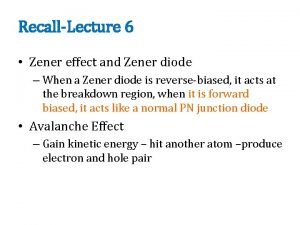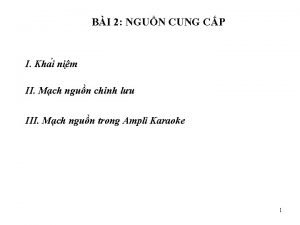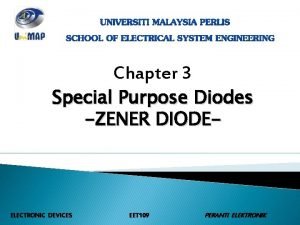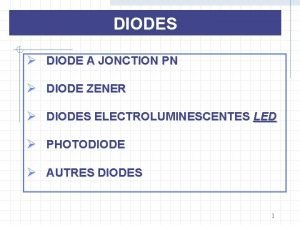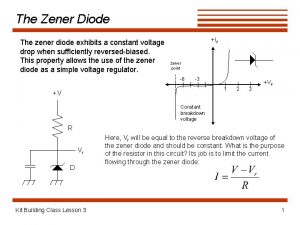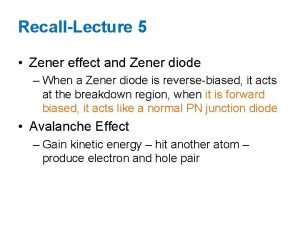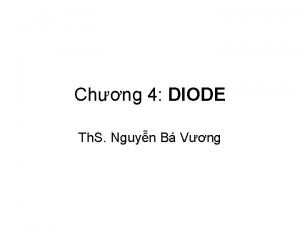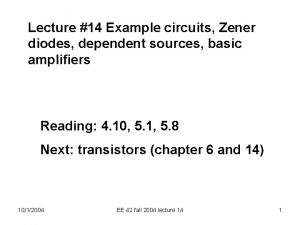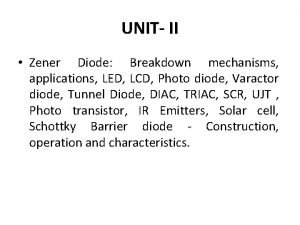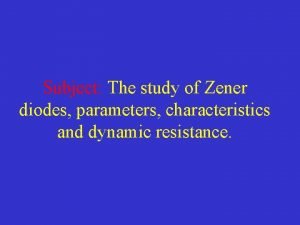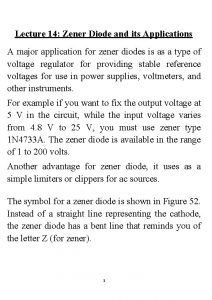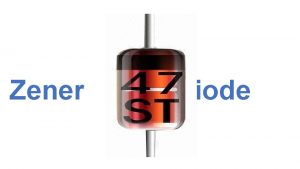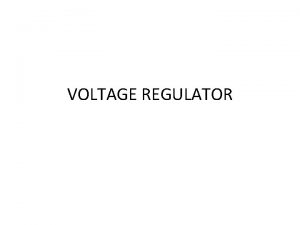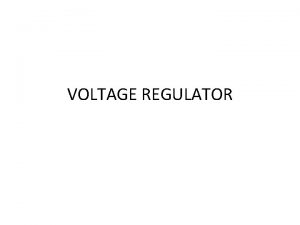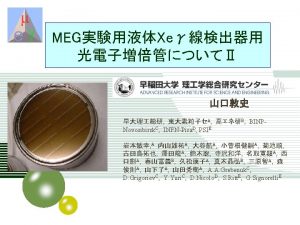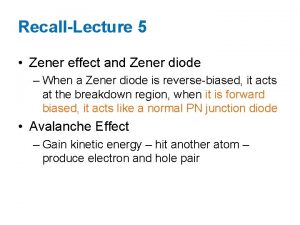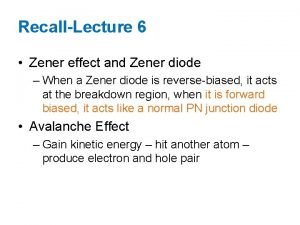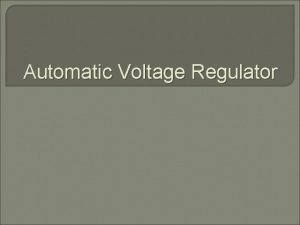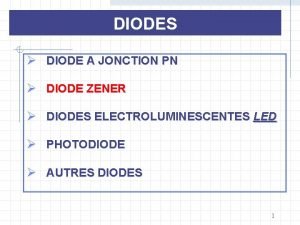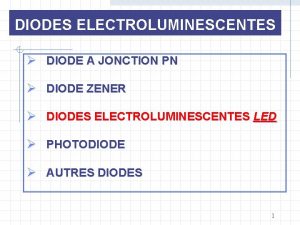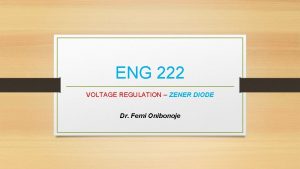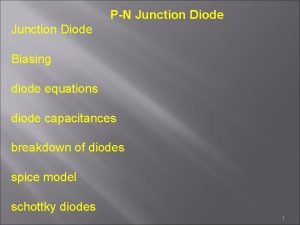Recall Lecture 7 Voltage Regulator using Zener Diode




















- Slides: 20

Recall Lecture 7 • Voltage Regulator using Zener Diode The remainder of VPS drops across Ri 1. The zener diode holds the voltage constant regardless of the current 2. The load resistor sees a constant voltage regardless of the current

• Rectification – transforming AC signal into a signal with one polarity – Half wave rectifier

Full Wave Rectifier • Center-Tapped • Bridge

Full-Wave Rectification – circuit with center-tapped transformer Ø Positive cycle, D 2 off, D 1 conducts; vo– vs + V = 0 vo = vs - V Ø Negative cycle, D 1 off, D 2 conducts; vo– vs + V = 0 vo = vs - V Ø Since a rectified output voltage occurs during both positive and negative cycles of the input signal, this circuit is called a full-wave rectifier. Ø Also notice that the polarity of the output voltage for both cycles is the same

v =v s m sin t vm V -V Notice again that the peak voltage of Vo is lower since vo = vs - V • vs < V , diode off, open circuit, no current flow, vo = 0 V

Full-Wave Rectification –Bridge Rectifier Ø Positive cycle, D 1 and D 2 conducts, D 3 and D 4 off; V + vo + V – vs = 0 vo = vs - 2 V Ø Negative cycle, D 3 and D 4 conducts, D 1 and D 2 off V + vo + V – vs = 0 vo = vs - 2 V ØAlso notice that the polarity of the output voltage for both cycles is the same

• A full-wave center-tapped rectifier circuit is shown in the figure below. Assume that for each diode, the cut-in voltage, V = 0. 6 V and the diode forward resistance, rf is 15. The load resistor, R = 95 . Determine: i. peak output voltage, vo across the load, R ii. Sketch the output voltage, vo and label its peak value. ( sine wave )

• SOLUTION i. peak output voltage, Vo vs (peak) = 125 / 25 = 5 V V +ID(15) + ID (95) - vs (peak) = 0 ID = (5 – 0. 6) / 110 = 0. 04 A vo (peak) = 95 x 0. 04 = 3. 8 V ii. 3. 8 V V -V

Rectifier Parameters Relationship between the number of turns of a step-down transformer and the input/output voltages

Duty Cycle: The fraction of the wave cycle over which the diode is conducting. one wave cycle 1 2

2 1 Multiply by 2

The peak inverse voltage (PIV) of the diode is the peak value of the voltage that a diode can withstand when it is reversed biased Type of Rectifier PIV Half Wave Peak value of the input secondary voltage, vs (peak) Full Wave : Center-Tapped 2 vs (peak)- V Full Wave: Bridge vs (peak) - V

EXAMPLE – Half Wave Rectifier Battery Charger Determine the currents and voltages of the half-wave rectifier circuit. Consider the half-wave rectifier circuit shown in Figure. Assume VB = 6 V, R = 120 Ω , V = 0. 6 V and vs(t) = 18. 6 sin t. Determine the peak diode current, maximum reverse-bias diode voltage, the fraction of the wave cycle over which the diode is conducting. -VR + VB + 18. 6 = 0 VR = 24. 6 V - VR + + A simple half-wave battery charger circuit

This node must be at least 6. 6 V 6 V

EXAMPLE – Full Wave Rectifier Battery Charger •

Determine the peak charging current of the battery vs = (156 / 20) = 7. 8 V Vγ + ID (0. 010) + VB + Vγ + ID (0. 010) – 7. 8 + = 0 ID = (7. 8 – 3. 6 – 1. 4) / 0. 020 = 140 m. A Maximum reverse biased voltage VR - 3. 6 + VR – VS = 0 2 VR = 7. 8 + 3. 6 = 11. 4 VR = 5. 7 V KVL

EXAMPLE – Half Wave Rectifier (PIV) Given a half wave rectifier with input primary voltage, Vp = 80 sin t and the transformer turns ratio, N 1/N 2 = 6. If the diode is ideal diode, (V = 0 V), determine the value of the peak inverse voltage. 1. Get the input of the secondary voltage: 80 / 6 = 13. 33 V 2. PIV for half-wave = Peak value of the input voltage = 13. 33 V

EXAMPLE – Full Wave Rectifier (PIV) Calculate the transformer turns ratio and the PIV voltages for each type of the full wave rectifier a) center-tapped b) bridge Assume the input voltage of the transformer is 220 V (rms), 50 Hz from AC main line source. The desired peak output voltage is 9 V ; also assume V = 0. 6 V.

Solution: For the center-tapped transformer circuit the peak voltage of the transformer secondary is required The peak output voltage = 9 V Output voltage, vo = vs - V Hence, vs = 9 + 0. 6 = 9. 6 V this is peak value! Must change to rms value Peak value = Vrms x 2 So, vs (rms) = 9. 6 / 2 = 6. 79 V The turns ratio of the primary to each secondary winding is The PIV of each diode: 2 vs (peak) - V = 2(9. 6) - 0. 6 = 19. 6 - 0. 6 = 18. 6 V

Solution: For the bridge transformer circuit the peak voltage of the transformer secondary is required The peak output voltage = 9 V Output voltage, vo= vs - 2 V Hence, vs = 9 + 1. 2 = 10. 2 V this is peak value! Must change to rms value Peak value = Vrms x 2 So, vs (rms) = 10. 2 / 2 = 7. 21 V The turns ratio of the primary to each secondary winding is The PIV of each diode: vs (peak) - V = 10. 2 - 0. 6 = 9. 6 V
 Shunt type voltage regulator
Shunt type voltage regulator Zener diode as voltage regulator
Zener diode as voltage regulator Pn junction diode and zener diode difference
Pn junction diode and zener diode difference Tvs diode vs zener
Tvs diode vs zener Peak inverse voltage formula
Peak inverse voltage formula Op amp voltage regulator circuit
Op amp voltage regulator circuit Applications of ac voltage controller
Applications of ac voltage controller Silicon diode resistance
Silicon diode resistance Zener effect
Zener effect Diode zener
Diode zener Zener diode example
Zener diode example Zener diode junction
Zener diode junction Zener diode exhibits
Zener diode exhibits Half wave rectifier with zener diode
Half wave rectifier with zener diode Diode zener
Diode zener Circuits with dependent sources
Circuits with dependent sources Energy band diagram of zener diode
Energy band diagram of zener diode Simbol dioda foto
Simbol dioda foto Zener diode parameters
Zener diode parameters Zener diodes applications
Zener diodes applications Zener diode function
Zener diode function

